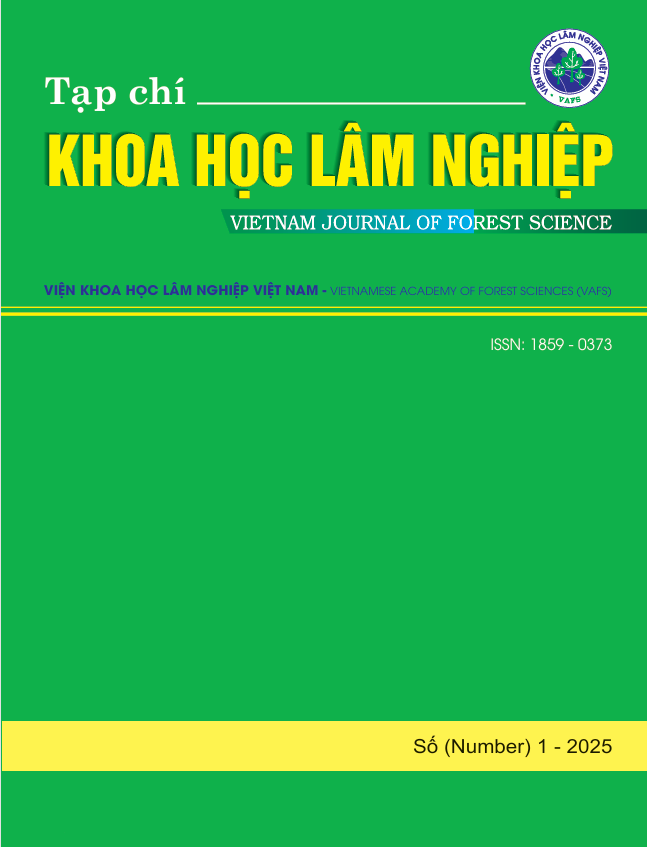MODELING THE DISTRIBUTION AND FACTORS INFLUENCING CAMELLIA FURFURACEA IN TA DUNG NATIONAL PARK, DAK NONG PROVINCE
DOI:
https://doi.org/10.70169/VJFS.1013Keywords:
Species distribution model, Camellia furfuracea, affect factor, bioclimatic variables, maxent, AUC, Ta Dung National ParkAbstract
This study focuses on modeling the distribution of the tea species (Camellia furfuracea) in Ta Dung National Park, Dak Nong province, Vietnam. The Maxent species distribution modeling method was used to identify the main environmental factors influencing the species' distribution. Input data included field information with 76 distribution points of the species, bioclimatic variables, topographic variables (altitude, slope, aspect), and land cover data. Results showed that the diurnal temperature range (Bio02) was the most important factor, contributing 41% to the model with an importance value of 85.3%; followed by forest cover (contribution of 51.6% and importance of 6.1%) and precipitation of the coldest quarter (Bio19) (contribution of 2.7% and importance of 5.4%). Areas with very high potential distribution are concentrated around the Ta Dung peak, where temperatures are low, and the diurnal temperature range is large. The model achieved high accuracy with an AUC value of 0.964. The research results provide a basis for the conservation and development of Camellia furfuracea in the Dak Nong region and can be extended to other rare species in the future.
References
Adekanmbi, A. A., & Sizmur, T., 2022. Importance of Diurnal Temperature Range (DTR) for predicting the temperature sensitivity of soil respiration. Frontiers in Soil Science, 2, 969077. https://doi.org/10.3389/fsoil.2022.969077
Dinerstein, E., Olson, D., Joshi, A., Vynne, C., Burgess, N. D., Wikramanayake, E., Hahn, N., Palminteri, S., Hedao, P., Noss, R., Hansen, M., Locke, H., Ellis, E. C., Jones, B., Barber, C. V., Hayes, R., Kormos, C., Martin, V., Crist, E., … Saleem, M., 2017. An Ecoregion-Based Approach to Protecting Half the Terrestrial Realm. BioScience, 67(6), 534–545. https://doi.org/10.1093/biosci/bix014
Dormann, C. F., Elith, J., Bacher, S., Buchmann, C., Carl, G., Carré, G., Marquéz, J. R. G., Gruber, B., Lafourcade, B., Leitão, P. J., Münkemüller, T., McClean, C., Osborne, P. E., Reineking, B., Schröder, B., Skidmore, A. K., Zurell, D., & Lautenbach, S., 2013. Collinearity: A review of methods to deal with it and a simulation study evaluating their performance. Ecography, 36(1), 27–46. https://doi.org/10.1111/j.1600-0587.2012.07348.x
Dubuis, A., Giovanettina, S., Pellissier, L., Pottier, J., Vittoz, P., & Guisan, A., 2013. Improving the prediction of plant species distribution and community composition by adding edaphic to topo‐climatic variables. Journal of Vegetation Science, 24(4), 593–606. https://doi.org/10.1111/jvs.12002
Dubuis, A., Pottier, J., Rion, V., Pellissier, L., Theurillat, J.-P., & Guisan, A., 2011. Predicting spatial patterns of plant species richness: A comparison of direct macroecological and species stacking modelling approaches: Predicting plant species richness. Diversity and Distributions, 17(6), 1122–1131. https://doi.org/10.1111/j.1472-4642.2011.00792.x
Elith, J., Kearney, M., & Phillips, S., 2010. The art of modelling range-shifting species: The art of modelling range-shifting species. Methods in Ecology and Evolution, 1(4), 330–342. https://doi.org/10.1111/j.2041-210X.2010.00036.x
Elith, J., Phillips, S. J., Hastie, T., Dudík, M., Chee, Y. E., & Yates, C. J., 2011. A statistical explanation of MaxEnt for ecologists: Statistical explanation of Maxent. Diversity and Distributions, 17(1), 43–57. https://doi.org/10.1111/j.1472-4642.2010.00725.x
Evans, B., & Lyons, T., 2013. Bioclimatic Extremes Drive Forest Mortality in Southwest, Western Australia. Climate, 1(2), 28–52. https://doi.org/10.3390/cli1020028
Naimi, B., Hamm, N. A. S., Groen, T. A., Skidmore, A. K., & Toxopeus, A. G., 2014. Where is positional uncertainty a problem for species distribution modelling? Ecography, 37(2), 191–203. https://doi.org/10.1111/j.1600-0587.2013.00205.x
Nguyen, Q., Mai, Q., Nguyen, M., Bui Thi, B. H., Doan, M., Le, T. M., Nguyen, P., Nguyen, T., & Nguyen Thi, T., 2024. Phytochemical Profiles and Biological Activities of Five Wild Camellia Species from Ta Dung, Vietnam. Chemistry & Biodiversity, e202401047. https://doi.org/10.1002/cbdv.202401047
Thanh Huong Thi, N., The Hien, N., Thi Hang, P., Thi Hoai, C., & Dinh Bao, H., 2024. Classification of forest cover of Ta Dung National Park, Vietnam using optical satellite images. IOP Conference Series: Earth and Environmental Science, 1391(1), 012018. https://doi.org/10.1088/1755-1315/1391/1/012018
Patrick Bell, Nictor Namoi, Christine Lamanna, Caitlin Corner-Dolloff, Evan H. Girvetz, Christian Thierfelder, & Todd S. Rosenstock., 2018. A practical guide to climate-smart agriculture technologies in Africa. CGIAR, 224.
Phillips, S. J., Anderson, R. P., & Schapire, R. E., 2006. Maximum entropy modeling of species geographic distributions. Ecological Modelling, 190(3), 231–259. https://doi.org/10.1016/j.ecolmodel.2005.03.026
Steven J. Phillips., 2017. A Brief Tutorial on Maxent. Center for Biodiversity and Conservation, American Museum of Natural History. http://biodiversityinformatics.amnh.org/open_source/maxent/Accessed on 2024-10-10
Sunil Kumar & Thomas J. Stohlgren., 2009. Maxent modeling for predicting suitable habitat for threatened and endangered tree. Journal of Ecology and Natural Environment, 1, 94–98.
Tianlu Min & Bruce Bartholomew., 2007, Tháng Mười-Một 19. Theaceae—Flora of China Illustrations. Science Press, Beijing, and Missouri Botanical Garden Press, St. Louis., volume 12. http://www.efloras.org/florataxon.aspx?flora_id=2&taxon_id=10882
Wakie, T. T., Evangelista, P. H., Jarnevich, C. S., & Laituri, M., 2014. Mapping Current and Potential Distribution of Non-Native Prosopis juliflora in the Afar Region of Ethiopia. PLoS ONE, 9(11), e112854. https://doi.org/10.1371/journal.pone.0112854
WFO., 2024. Camellia furfuracea (Merr.) Cohen-Stuart [Dataset]. http://www.worldfloraonline.org/taxon/wfo-0000582353









